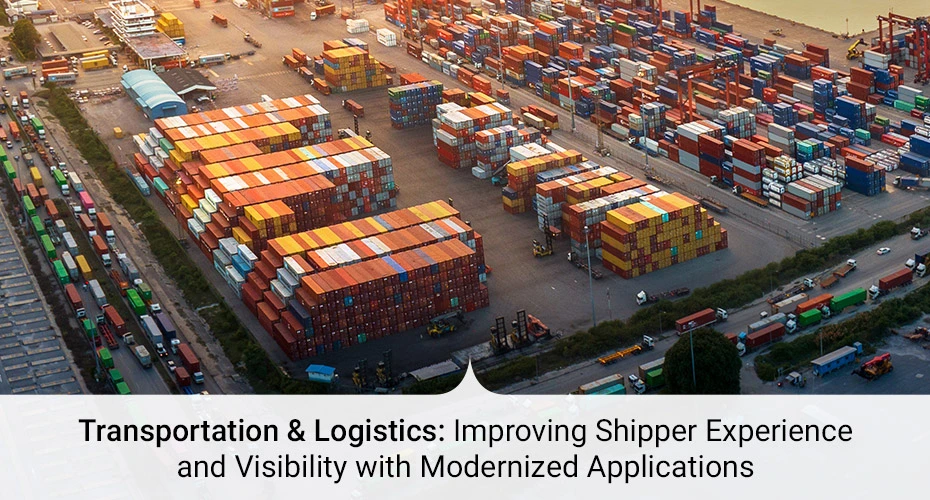The transportation and logistics industry is crucial for the seamless movement of goods worldwide. As supply chains become increasingly complex and globalized, shippers demand greater visibility, efficiency, and control over their shipments. However, traditional processes and systems often fall short, resulting in operational challenges.

For the success of this industry, it is of utmost importance that the shippers themselves have an optimal experience to enable maximum operational efficiency. With rising consumer expectations and intense competition, addressing shipper experience shortcomings is critical for companies to gain a competitive edge.
In the previous blog, we explored how tailored applications solve unique challenges in transportation and logistics, including streamlined workflows, improved visibility, system integration, and data security.
In this third and final part of our three-part blog series, we will discuss how modernized applications and custom software development can enhance the shipper experience and improve visibility within this critical sector, enabling more excellent optimization and business success.
What is the Problem?
Shippers face various challenges that complicate their operations and affect their ability to meet customer expectations. These issues stem from outdated practices, inefficiencies, and communication barriers that hinder effective management and decision-making. Some of the most pressing problems include:
1. Lack of Real-time Visibility into Shipment Status
One of the significant challenges shippers face is the absence of accurate and up-to-date information about the location and status of their shipments. This lack of visibility hinders effective planning and timely response to potential disruptions, such as delays, weather events, or demand fluctuations, leading to inefficient decision-making, missed delivery windows, and dissatisfied customers.
2. Manual Processes and Inefficiencies
Despite the digital age, many transportation and logistics companies rely heavily on manual processes like paper-based documentation, phone calls, and spreadsheets. These outdated methods are time-consuming and error-prone, hindering real-time collaboration among stakeholders. This results in inefficiencies that impact customer satisfaction and profitability.
3. Limited Collaboration and Communication with Carriers
Seamless communication and collaboration between shippers and carriers is crucial for ensuring timely deliveries and promptly addressing transit-related issues. However, traditional communication methods often lack efficiency, leading to misaligned expectations, suboptimal performance, and strained relationships between shippers and their logistics partners.
4. Difficulty Managing Multiple Carriers and Modes of Transportation
Companies that leverage numerous carriers and modes of transportation frequently grapple with the complexity of effectively managing and coordinating these various options. This can result in operational inefficiencies, increased costs, and difficulties in optimizing routes and modes based on crucial factors like cost, speed, and environmental impact.
What Comes to the Rescue?
Modernized Applications. When we refer to modernized apps or platforms, we are talking about cutting-edge software solutions that leverage advanced technologies like cloud computing, artificial intelligence, and real-time data analytics powered by GPS, ELD, and mobile platforms. These offer a comprehensive solution to address shippers’ challenges and significantly improve their experience and visibility across the supply chain. Such visibility also helps boost customer trust and loyalty while improving retention.
They enhance operational efficiency and foster customer retention, loyalty, and trust by providing unparalleled transparency and real-time insights into shipment status. The increased visibility and seamless communication enabled by these applications strengthen the relationship between shippers and their customers, solidifying their position in the market.
The functionalities of modernized applications that improve visibility include:
1. Real-time Shipment Tracking with Detailed Information
Shippers can access real-time updates on the status and location of their shipments, enabling proactive decision-making and better communication with customers. Advanced tracking technologies, such as GPS, RFID, and IoT sensors, provide granular data on shipment movements, temperatures, and other critical parameters, ensuring transparency and accountability throughout the supply chain.
2. Automated Notifications and Alerts on Shipment Status Changes
Modernized applications can automatically notify shippers of any changes or delays in shipment status, allowing for timely response and contingency planning. These notifications can be tailored to specific customer requirements or predefined thresholds, ensuring that the correct information reaches stakeholders at the right time.
3. Predictive Data Analytics and Dashboards for Proactive Management
Advanced predictive analytics and customizable dashboards provide shippers with actionable insights, enabling them to identify potential bottlenecks, optimize routes, and make data-driven decisions. By leveraging historical data, machine learning algorithms, and predictive analytics, these applications can forecast demand patterns, anticipate disruptions, and recommend proactive measures to mitigate risks and improve operational efficiency.
4. Integration with Various Logistics Platforms for End-to-End Visibility
Modernized applications can seamlessly integrate with the systems of carriers, logistics providers, customs agencies, and other partners, ensuring end-to-end visibility across the entire supply chain. This integration facilitates real-time data sharing, enabling all stakeholders to access accurate and consistent information, fostering collaboration, and improving decision-making.
Business Benefits of Improved Shipper Experience and Visibility
By implementing modernized applications, companies in the transportation and logistics industry can unlock significant business benefits:
1. Customer Experience Powered by Technology
Modernized applications provide end customers with self-service portals and real-time visibility into the shipment journey. These customer-facing platforms offer complete control and transparency, allowing customers to track their shipments, access detailed information, and receive proactive updates on status changes. This level of visibility and engagement enhances the overall customer experience, fostering trust and satisfaction.
2. Increased Efficiency and Reduced Costs
Streamlined processes, automated workflows, and well-designed routes improve operational efficiency and cost savings. Companies can achieve significant productivity gains and cost reductions by eliminating manual tasks, reducing errors, and optimizing resource utilization.
3. Improved Decision-making and Risk Management
Real-time visibility and advanced analytics enable shippers to make informed decisions, mitigate risks, and respond quickly to disruptions or changes in demand. By leveraging predictive analytics and scenario modeling, companies can proactively identify potential issues and implement contingency plans, minimizing the impact on operations and customer satisfaction.
4. Enhanced customer satisfaction through faster deliveries
By optimizing processes and improving visibility, shippers can ensure timely deliveries and provide customers with accurate updates on shipment status. This transparency and reliability can lead to higher customer satisfaction levels, fostering long-term relationships and customer loyalty.
5. Stronger Relationships with Carriers and Logistics Providers
Modernized applications facilitate seamless integration and collaboration with carriers and logistics providers, fostering more robust partnerships and enabling better service levels. Real-time data sharing, automated workflows, and streamlined communication enhance trust and allow all parties to work together more effectively, ultimately benefiting the end customer.
Modernized Applications for Shipper Visibility and Success
As the industry evolves and customer expectations rise, investing in modernized applications will be essential for staying competitive and delivering exceptional service. This concludes our three-part blog series, which has explored the digital transformation journey in the transportation and logistics industry and highlighted the multifaceted approach necessary for companies to thrive in the digital era.
Modernized applications can take your logistics to new heights. Discover how Synoptek’s custom software development services can transform your company into an industry leader through digital innovation. Contact us today!
About the Author
Parth Jani is a Principal Consultant with over 13 years of industry experience and brings a comprehensive skill set spanning technology and business domains. With a proven track record in presales, project execution, and product management, Parth transforms ideas into valuable solutions via business analysis and solution architecting. He has led numerous transportation and logistics projects, demonstrating deep sector knowledge. His strategic thinking and attention to operational details enable him to drive success throughout the business lifecycle while fostering team growth and collaborating closely with executives to enhance business performance.






